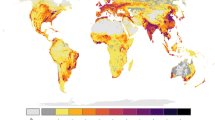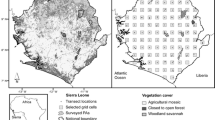Abstract
The geographical distribution of terrestrial vertebrate biodiversity was assessed in Southeast Asia, an area characterized by highly heterogeneous human population densities (HPDs). We tested the hypothesis that recent (between 1990 and 2000) population increases may result in increased threats to biodiversity. GIS data were compiled from the International Union for the Conservation of Nature, BirdLife, and the Socioeconomic Data and Applications Center. Polygon data sets were transformed into rasters with different resolutions from 2.5\('\) to 1\(^{\circ }.\) Relationships between species diversity were assessed globally and separately for terrestrial vertebrates (mammals, birds, reptiles, and amphibians) and for five countries (Cambodia, Laos, Myanmar, Thailand, and Vietnam). The number of species within a 20 km\(^{2}\)-cell varied greatly and reached a maximum of 801. The species-rich cells (\(>700\) species) were located in a single, almost continuous area across Myanmar, Thailand, Vietnam, and South China. The relationship between vertebrate biodiversity and population density showed that biodiversity increased with HPD until around 10 persons km\(^{-2},\) then decreased until around 200 persons km\(^{-2}\) where it stabilized. This relationship was mediated by land cover and protection status with significant interactions between these variables and with population density. The areas with moderately increasing populations between 1990 and 2000 were those with the highest overall diversity (median 607) whereas those with decreasing populations were those with the lowest diversity (median 479). Our results suggest that population pressure on biodiversity has increased between 1990 and 2000 and this is a relatively widespread phenomenon. The presence of a continuous area of high vertebrate biodiversity calls for international action at a regional scale involving China, Laos, Myanmar, Thailand, and Vietnam.






Similar content being viewed by others
References
Akaike H (1973) Information theory and an extension of the maximum likelihood principle. In: Petrov BN, Csaki F (eds) Proceedings of the second international symposium on information theory. Akadémia Kiado, Budapest, p 267–281
Alberti M, Correa C, Marzluff JM, Hendry AP, Palkovacs EP, Gotanda KM, Hunt VM, Apgar TM, Zhou Y (2017) Global urban signatures of phenotypic change in animal and plant populations. Proc Natl Acad Sci USA 114(34):8951–8956. https://doi.org/10.1073/pnas.1606034114
Barbosa AM, Pautasso M, Figueiredo D (2013) Species–people correlations and the need to account for survey effort in biodiversity analyses. Divers Distrib 19(9):1188–1197. https://doi.org/10.1111/ddi.12106
BirdLife International and Handbook of the Birds of the World (2016) Bird species distribution maps of the world. Version 6
Bivand R, Lewin-Koh N (2015) maptools: tools for reading and handling spatial objects. R package version 0.8-36. http://CRAN.R-project.org/package=maptools
Bivand R, Keitt T, Rowlingson B (2015) rgdal: bindings for the Geospatial Data Abstraction Library. R package version 1.0-7. http://CRAN.R-project.org/package=rgdal
Ceballos G, Ehrlich PR, Dirzo R (2017) Biological annihilation via the ongoing sixth mass extinction signaled by vertebrate population losses and declines. Proc Natl Acad Sci USA 114(30):E6089–E6096. https://doi.org/10.1073/pnas.1704949114
Center for International Earth Science Information Network, CIESIN, Columbia University; and Centro Internacional de Agricultura Tropical, CIAT (2005) Gridded population of the world version 3 (GPWv3): population density grids. Socioeconomic Data and Applications Center (SEDAC), Columbia University, Palisades. http://sedac.ciesin.columbia.edu/gpw. Accessed 28 July 2016
Cincotta RP, Wisnewski J, Engelman R (2000) Human population in the biodiversity hotspots. Nature 404:990–992. https://doi.org/10.1038/35010105
da Silva FR, Prouete DB, Hawkins BA (2016) Range maps and checklists provide similar estimates of taxonomic and phylogenetic alpha diversity, but less so for beta diversity, of Brazilian Atlantic Forest anurans. Nat Conserv 14(2):99–105. https://doi.org/10.1016/j.ncon.2016.07.001
Di Minin E, Slotow R, Hunter LTB, Pouzols FM, Toivonen T, Verburg PH, Leader-Williams N, Petracca L, Moilanen A (2016) Global priorities for national carnivore conservation under land use change. Sci Rep 6(23):814. https://doi.org/10.1038/srep23814
Essl F, Winter M, Pyšek P (2012) Trade threat could be even more dire. Nature 487:39. https://doi.org/10.1038/487039b
Fjeldså J, Burgess ND (2008) The coincidence of biodiversity patterns and human settlement in Africa. Afr J Ecol 46(1):33–42. https://doi.org/10.1111/j.1365-2028.2008.00927.x
Hansen MC, Defries RS, Townshend JRG, Sohlberg R (2000) Global land cover classification at 1 km spatial resolution using a classification tree approach. Int J Remote Sens 21(6–7):1331–1364. https://doi.org/10.1080/014311600210209
Hansen MC, Potapov PV, Moore R, Hancher M, Turubanova SA, Tyukavina A, Thau D, Stehman SV, Goetz SJ, Loveland TR, Kommareddy A, Egorov A, Chini L, Justice CO, Townshend JRG (2013) High-resolution global maps of 21st-century forest cover change. Science 342:850–853. https://doi.org/10.1126/science.1244693
Hastie TJ, Tibshirani RJ, Friedman J (2001) The elements of statistical learning. Data mining, inference, and prediction. Springer, New York
Hijmans RJ (2015) raster: geographic data analysis and modeling. R package version 2.4-20. http://CRAN.R-project.org/package=raster
Hughes AC (2017) Mapping priorities for conservation in Southeast Asia. Biol Conserv 209:395–405. https://doi.org/10.1016/j.biocon.2017.03.007
Hurlbert AH, Jetz W (2007) Species richness, hotspots, and the scale dependence of range maps in ecology and conservation. Proc Natl Acad Sci USA 104(33):13384–13389. https://doi.org/10.1073/pnas.0704469104
IUCN (2014) The IUCN Red List of Threatened Species. Version 2014.1. http://www.iucnredlist.org/. Accessed 17 July 2014
Jetz W, Sekercioglu CH, Watson JEM (2008) Ecological correlates and conservation implications of overestimating species geographic ranges. Conserv Biol 22(1):110–119. https://doi.org/10.1111/j.1523-1739.2007.00847.x
Koh LP, Sodhi NS (2010) Conserving Southeast Asia’s imperiled biodiversity: scientific, management, and policy challenges. Biodivers Conserv 19(4):913–917. https://doi.org/10.1007/s10531-010-9818-9
Lenzen M, Moran D, Kanemoto K, Foran B, Lobefaro L, Geschke A (2012) International trade drives biodiversity threats in developing nations. Nature 486:109–112. https://doi.org/10.1038/nature11145
Li BBV, Hughes AC, Jenkins CN, Ocampo-Peñuela N, Pimm SL (2016) Remotely sensed data informs Red List evaluations and conservation priorities in Southeast Asia. PLoS ONE 11(8):e0160566. https://doi.org/10.1371/journal.pone.0160566
Luck GW (2010) Why is species richness often higher in more densely populated regions? Anim Conserv 13(5):442–443. https://doi.org/10.1111/j.1469-1795.2010.00396.x
Newbold T, Hudson LN, Arnell AP, Contu S, De Palma A, Ferrier S, Hill SLL, Hoskins AJ, Lysenko I, Phillips HRP, Burton VJ, Chng CWT, Emerson S, Gao D, Pask-Hale G, Hutton J, Jung M, Sanchez-Ortiz K, Simmons BI, Whitmee S, Zhang HB, Scharlemann JPW, Purvis A (2016) Has land use pushed terrestrial biodiversity beyond the planetary boundary? A global assessment. Science 353:288–291. https://doi.org/10.1126/science.aaf2201
Nijman V (2010) An overview of international wildlife trade from Southeast Asia. Biodivers Conserv 19(4):1101–1114. https://doi.org/10.1007/s10531-009-9758-4
Ocampo-Peñuela N, Jenkins CN, Vijay V, Li BV, Pimm SL (2016) Incorporating explicit geospatial data shows more species at risk of extinction than the current Red List. Sci Adv 2(11):e1601367. https://doi.org/10.1126/sciadv.1601367
Pinheiro J, Bates D, DebRoy S, Sarkar D, R Core Team (2017) nlme: linear and nonlinear mixed effects models. R package version 3.1-131. https://CRAN.R-project.org/package=nlme
Pinheiro JC, Bates DM (2000) Mixed-effects models in S and S-PLUS. Springer, New York
Pollock LJ, Thuiller W, Jetz W (2017) Large conservation gains possible for global biodiversity facets. Nature 546:141–144. https://doi.org/10.1038/nature22368
R Core Team (2017) R: a language and environment for statistical computing. R Foundation for Statistical Computing, Vienna. http://www.R-project.org
Ripple WJ, Estes JA, Beschta RL, Wilmers CC, Ritchie EG, Hebblewhite M, Berger J, Elmhagen B, Letnic M, Nelson MP, Schmitz OJ, Smith DW, Wallach AD, Wirsing AJ (2014) Status and ecological effects of the world’s largest carnivores. Science 343:151. https://doi.org/10.1126/science.1241484
Ripple WJ, Newsome TM, Wolf C, Dirzo R, Everatt KT, Galetti M, Hayward MW, Levi T, Lindsey PA, Macdonald DW, Malhi Y, Painter LE, Sandom CJ, Terborgh J, Van Valkenburgh B (2015) Collapse of the world’s largest herbivores. Sci Adv 1:e1400103. https://doi.org/10.1126/sciadv.1400103
Schwarz G (1978) Estimating the dimension of a model. Ann Stat 6(2):461–464. https://doi.org/10.1214/aos/1176344136
Tantipisanuh N, Gale GA (2013) Representation of threatened vertebrates by a protected area system in Southeast Asia: the importance of non-forest habitats. Raffles Bull Zool 61(1):359–395
Tantipisanuh N, Savini T, Cutter P, Gale GA (2016) Biodiversity gap analysis of the protected area system of the Indo-Burma Hotspot and priorities for increasing biodiversity representation. Biol Conserv 195:203–213. https://doi.org/10.1016/j.biocon.2015.12.043
Taylor D (2010) Biomass burning, humans and climate change in Southeast Asia. Biodivers Conserv 19(4):1025–1042. https://doi.org/10.1007/s10531-009-9756-6
Trisurat Y, Alkemade R, Verburg PH (2010) Projecting land-use change and its consequences for biodiversity in northern Thailand. Environ Manag 45(3):626–639. https://doi.org/10.1007/s00267-010-9438-x
Trisurat Y, Kanchanasaka B, Kreft H (2014) Assessing potential effects of land use and climate change on mammal distributions in northern Thailand. Wildl Res 41(6):522–536. https://doi.org/10.1071/WR14171
Woodruff DS (2010) Biogeography and conservation in Southeast Asia: how 2.7 million years of repeated environmental fluctuations affect today’s patterns and the future of the remaining refugial-phase biodiversity. Biodivers Conserv 19(4):919–941. https://doi.org/10.1007/s10531-010-9783-3
Acknowledgements
I am grateful to three anonymous reviewers and the Associate Editor for their positive and constructive comments on a previous version of this paper. This is publication ISEM 2018-094.
Author information
Authors and Affiliations
Corresponding author
Additional information
Communicated by David Hawksworth.
This article belongs to the Topical Collection: Urban biodiversity.
Electronic supplementary material
Below is the link to the electronic supplementary material.
Rights and permissions
About this article
Cite this article
Paradis, E. Nonlinear relationship between biodiversity and human population density: evidence from Southeast Asia. Biodivers Conserv 27, 2699–2712 (2018). https://doi.org/10.1007/s10531-018-1563-5
Received:
Revised:
Accepted:
Published:
Issue Date:
DOI: https://doi.org/10.1007/s10531-018-1563-5




